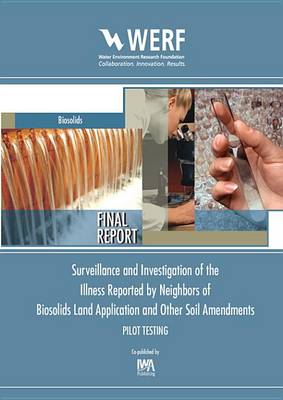WERF Research Report
1 total work
Available as eBook only.
The research team field-tested a draft 5-step protocol over the length of the project from May 2009 until October 2010 on XX number of complaints (20 from May 2009 to September 2010). The protocol includes three questionnaires administered to: neighbors of land application sites alleging health effects or nuisance odors; biosolids generators; and biosolids appliers; and two additional investigation reports locating and describing the land application site(s) of concern. The research team evaluated the health questionnaire using cognitive interviews to determine if any biases exist within both the structure and organization of the questionnaire, the wording, and order of the questions, or with the methods of administration. They evaluated the generator and applier questionnaires by field-testing and with a focus group of generators and appliers. The research team removed or reduced biases identified through these evaluations to improve validity and reliability by refining the original health questionnaire four times and the applier and generator questionnaires twice. The team designed the protocol so that a broad base of potential end-users and stakeholders (a person or group with a direct interest, involvement, or investment in something), can apply it accurately, efficiently, and effectively as a component of a future standardized surveillance and rapid response investigation system throughout the country.
An outreach and implementation communication plan and a guidance document that suggests study designs for future research, based upon the clues obtained from this project and a literature review, were also developed. Future stakeholders will measure the success of the project by the sustained use of the protocol as the national surveillance system, which would collect a large sample of quality, valid, and standardized data on allegations of health effects. Based upon these data, future researchers will design studies to improve our understanding of the relationship of these concerns to the land application of biosolids and other soils amendments.
The research team field-tested a draft 5-step protocol over the length of the project from May 2009 until October 2010 on XX number of complaints (20 from May 2009 to September 2010). The protocol includes three questionnaires administered to: neighbors of land application sites alleging health effects or nuisance odors; biosolids generators; and biosolids appliers; and two additional investigation reports locating and describing the land application site(s) of concern. The research team evaluated the health questionnaire using cognitive interviews to determine if any biases exist within both the structure and organization of the questionnaire, the wording, and order of the questions, or with the methods of administration. They evaluated the generator and applier questionnaires by field-testing and with a focus group of generators and appliers. The research team removed or reduced biases identified through these evaluations to improve validity and reliability by refining the original health questionnaire four times and the applier and generator questionnaires twice. The team designed the protocol so that a broad base of potential end-users and stakeholders (a person or group with a direct interest, involvement, or investment in something), can apply it accurately, efficiently, and effectively as a component of a future standardized surveillance and rapid response investigation system throughout the country.
An outreach and implementation communication plan and a guidance document that suggests study designs for future research, based upon the clues obtained from this project and a literature review, were also developed. Future stakeholders will measure the success of the project by the sustained use of the protocol as the national surveillance system, which would collect a large sample of quality, valid, and standardized data on allegations of health effects. Based upon these data, future researchers will design studies to improve our understanding of the relationship of these concerns to the land application of biosolids and other soils amendments.
